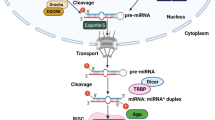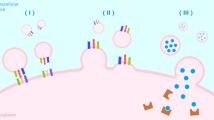Abstract
Exosomes are extracellularly secreted vesicles ranging from 40 to 100 nm in diameter that are thought to play important roles in intercellular communication. Exosomes contain numerous proteins, RNA, and lipids that can affect the status of recipient cells under various pathological conditions. MicroRNAs (miRNAs) are small non-coding RNAs that play a major role in post-transcriptional gene silencing by interacting with the 3′-untranslated regions of target genes. Epstein-Barr virus (EBV) has been reported to induce sustained elevation of cellular miRNAs such as miR-155. We hypothesized that miRNAs delivered by exosomes might affect the angiogenesis of retinal pigment epithelial (RPE) cells. Here, we demonstrated that co-culture of EBV-positive Burkitt’s lymphoma (BL) cells (Raji) with retinal pigment epithelial (ARPE-19) cells increased the level of miR-155 in recipient cells whereas no major difference was detected for co-culture with EBV-negative BL cells (Ramos). Isolated Raji exosomes increased transcriptional and translational levels of VEGF-A in ARPE-19 cells, which was reversely correlated with von Hippel-Lindau expression. A human umbilical vein endothelial cell tube formation assay showed that delivery of ectopic miR-155 rendered ARPE-19 cells proangiogenic. Our results demonstrate that sustained accumulation of miR-155 mediated by exosomes might affect remote recipient cells such as retinal pigment epithelial cells.





Similar content being viewed by others
Abbreviations
- miR:
-
MicroRNA
- EBV:
-
Epstein-Barr virus
- miR-155:
-
miRNA-155
References
Mathivanan S, Ji H, Simpson RJ. Exosomes: extracellular organelles important in intercellular communication. J Proteome. 2010;73:1907–20.
Raposo G, Stoorvogel W. Extracellular vesicles: exosomes, microvesicles, and friends. J Cell Biol. 2013;200:373–83.
Thery C, Boussac M, Veron P, Ricciardi-Castagnoli P, Raposo G, Garin J, et al. Proteomic analysis of dendritic cell-derived exosomes: a secreted subcellular compartment distinct from apoptotic vesicles. J Immunol. 2001;166:7309–18.
Xie Y, Bai O, Zhang H, Yuan J, Zong S, Chibbar R, et al. Membrane-bound hsp70-engineered myeloma cell-derived exosomes stimulate more efficient cd8(+) ctl- and nk-mediated antitumour immunity than exosomes released from heat-shocked tumour cells expressing cytoplasmic hsp70. J Cell Mol Med. 2010;14:2655–66.
Laulagnier K, Vincent-Schneider H, Hamdi S, Subra C, Lankar D, Record M. Characterization of exosome subpopulations from rbl-2h3 cells using fluorescent lipids. Blood Cells Mol Dis. 2005;35:116–21.
Mazurov D, Barbashova L, Filatov A. Tetraspanin protein cd9 interacts with metalloprotease cd10 and enhances its release via exosomes. FEBS J. 2013;280:1200–13.
Mulcahy LA, Pink RC, Carter DR. Routes and mechanisms of extracellular vesicle uptake. J Extracell Vesicles. 2014;3.
Zhang J, Li S, Li L, Li M, Guo C, Yao J, et al. Exosome and exosomal microrna: trafficking, sorting, and function. Genomics Proteomics Bioinformatics. 2015;13:17–24.
Pant S, Hilton H, Burczynski ME. The multifaceted exosome: biogenesis, role in normal and aberrant cellular function, and frontiers for pharmacological and biomarker opportunities. Biochem Pharmacol. 2012;83:1484–94.
Wilczynska A, Bushell M. The complexity of mirna-mediated repression. Cell Death Differ. 2015;22:22–33.
Lu F, Weidmer A, Liu CG, Volinia S, Croce CM, Lieberman PM. Epstein-barr virus-induced mir-155 attenuates nf-kappab signaling and stabilizes latent virus persistence. J Virol. 2008;82:10436–43.
Gatto G, Rossi A, Rossi D, Kroening S, Bonatti S, Mallardo M. Epstein-barr virus latent membrane protein 1 trans-activates mir-155 transcription through the nf-kappab pathway. Nucleic Acids Res. 2008;36:6608–19.
Kutty RK, Nagineni CN, Samuel W, Vijayasarathy C, Hooks JJ, Redmond TM. Inflammatory cytokines regulate microrna-155 expression in human retinal pigment epithelial cells by activating jak/stat pathway. Biochem Biophys Res Commun. 2010;402:390–5.
Kong W, He L, Richards EJ, Challa S, Xu CX, Permuth-Wey J, et al. Upregulation of mirna-155 promotes tumour angiogenesis by targeting vhl and is associated with poor prognosis and triple-negative breast cancer. Oncogene. 2014;33:679–89.
Xiao H, Gu Z, Wang G, Zhao T. The possible mechanisms underlying the impairment of hif-1alpha pathway signaling in hyperglycemia and the beneficial effects of certain therapies. Int J Med Sci. 2013;10:1412–21.
Shtam TA, Kovalev RA, Varfolomeeva EY, Makarov EM, Kil YV, Filatov MV. Exosomes are natural carriers of exogenous sirna to human cells in vitro. Cell Commun Signal. 2013;11:88.
Kluiver J, Poppema S, de Jong D, Blokzijl T, Harms G, Jacobs S, et al. Bic and mir-155 are highly expressed in hodgkin, primary mediastinal and diffuse large b cell lymphomas. J Pathol. 2005;207:243–9.
Tam W, Dahlberg JE. Mir-155/bic as an oncogenic microrna. Genes Chromosomes Cancer. 2006;45:211–2.
Kluiver J, Haralambieva E, de Jong D, Blokzijl T, Jacobs S, Kroesen BJ, et al. Lack of bic and microrna mir-155 expression in primary cases of burkitt lymphoma. Genes Chromosomes Cancer. 2006;45:147–53.
Iqbal J, Shen Y, Huang X, Liu Y, Wake L, Liu C, et al. Global microrna expression profiling uncovers molecular markers for classification and prognosis in aggressive b-cell lymphoma. Blood. 2015;125:1137–45.
Rahadiani N, Takakuwa T, Tresnasari K, Morii E, Aozasa K. Latent membrane protein-1 of epstein-barr virus induces the expression of b-cell integration cluster, a precursor form of microrna-155, in b lymphoma cell lines. Biochem Biophys Res Commun. 2008;377:579–83.
Snell CE, Turley H, McIntyre A, Li D, Masiero M, Schofield CJ, et al. Proline-hydroxylated hypoxia-inducible factor 1alpha (hif-1alpha) upregulation in human tumours. PLoS One. 2014;9, e88955.
Min JH, Yang H, Ivan M, Gertler F, Kaelin Jr WG, Pavletich NP. Structure of an hif-1alpha -pvhl complex: hydroxyproline recognition in signaling. Science. 2002;296:1886–9.
Neal CS, Michael MZ, Rawlings LH, Van der Hoek MB, Gleadle JM. The vhl-dependent regulation of micrornas in renal cancer. BMC Med. 2010;8:64.
Maxwell PH, Wiesener MS, Chang GW, Clifford SC, Vaux EC, Cockman ME, et al. The tumour suppressor protein vhl targets hypoxia-inducible factors for oxygen-dependent proteolysis. Nature. 1999;399:271–5.
Hon WC, Wilson MI, Harlos K, Claridge TD, Schofield CJ, Pugh CW, et al. Structural basis for the recognition of hydroxyproline in hif-1 alpha by pvhl. Nature. 2002;417:975–8.
Baldewijns MM, van Vlodrop IJ, Vermeulen PB, Soetekouw PM, van Engeland M, de Bruine AP. Vhl and hif signalling in renal cell carcinogenesis. J Pathol. 2010;221:125–38.
Czyzyk-Krzeska MF, Zhang X. Mir-155 at the heart of oncogenic pathways. Oncogene. 2014;33:677–8.
de Jong PT. Age-related macular degeneration. N Engl J Med. 2006;355:1474–85.
Topouzis F, Anastasopoulos E, Augood C, Bentham GC, Chakravarthy U, de Jong PT, et al. Association of diabetes with age-related macular degeneration in the EUREYE study. Br J Ophthalmol. 2009;93:1037–41.
Hong GK, Kumar P, Wang PL, Damania B, Gulley ML, Delecluse HJ, et al. Epstein-Barr virus lytic infection is required for efficient production of the angiogenesis factor vascular endothelial growth factor in lymphoblastoid cell lines. J Virol. 2005;79:13984–92.
Jones RJ, Seaman WT, Feng WT, Barlow E, Dickerson S, Delecluse HJ, et al. Roles of lytic viral infection and IL-6 in early versus late passage lymphoblastoid cell lines and EBV-associated lymphoproliferative disease. Int J Cancer. 2007;121:1274–81.
Slobod KS, Sandlund JT, Spiegel PH, Haik B, Hurwitz JL, Conley ME, et al. Molecular evidence of ocular Epstein-Barr virus infection. Clin Infect Dis. 2000;31:184–8.
Meckes Jr DG, Gunawardena HP, Dekroon RM, Heaton PR, Edwards RH, Ozgur S, et al. Modulation of B-cell exosome proteins by gamma herpesvirus infection. Proc Natl Acad Sci U S A. 2013;110:E2925–33.
Andrade TA, Evangelista AF, Campos AH, Poles WA, Borges NM, Camillo CM, et al. A microRNA signature profile in EBV+ diffuse large B-cell lymphoma of the elderly. Oncotarget. 2014;5:11813–26.
Urbich C, Kuehbacher A, Dimmeler S. Role of microRNAs in vascular diseases, inflammation, and angiogenesis. Cardiovasc Res. 2008;79:581–8.
Fish JE, Santoro MM, Morton SU, Yu S, Yeh RF, Wythe JD, et al. miR-126 regulates angiogenic signaling and vascular integrity. Dev Cell. 2008;15:272–84.
Yoon C, Kim D, Kim S, Park GB, Hur DY, Yang JW, et al. Mir-9 regulates the post-transcriptional level of vegf165a by targeting srpk-1 in arpe-19 cells. Graefe's Arch Clin Exp Ophthal. 2014;252:1369–76.
Kelly TJ, Souza AL, Clish CB, Puigserver P. A hypoxia-induced positive feedback loop promotes hypoxia-inducible factor 1alpha stability through mir-210 suppression of glycerol-3-phosphate dehydrogenase 1-like. Mol Cell Biol. 2011;31:2696–706.
Ma L, Young J, Prabhala H, Pan E, Mestdagh P, Muth D, et al. Mir-9, a myc/mycn-activated microrna, regulates e-cadherin and cancer metastasis. Nat Cell Biol. 2010;12:247–56.
Coolen M, Katz S, Bally-Cuif L. Mir-9: a versatile regulator of neurogenesis. Front Cell Neurosci. 2013;7:220.
Thiele S, Wittmann J, Jack HM, Pahl A. Mir-9 enhances il-2 production in activated human cd4(+) t cells by repressing blimp-1. Eur J Immunol. 2012;42:2100–8.
Acknowledgments
This study was supported by the National Research Foundation of Korea (NRF) grant funded by the Korean government (MSIP) (R13-2007-023-00000-0) and Basic Science Research Program through NRF funded by the Ministry of Education (NRF-2012R1A1A2006909).
Author information
Authors and Affiliations
Corresponding author
Rights and permissions
About this article
Cite this article
Yoon, C., Kim, J., Park, G. et al. Delivery of miR-155 to retinal pigment epithelial cells mediated by Burkitt’s lymphoma exosomes. Tumor Biol. 37, 313–321 (2016). https://doi.org/10.1007/s13277-015-3769-4
Received:
Accepted:
Published:
Issue Date:
DOI: https://doi.org/10.1007/s13277-015-3769-4




